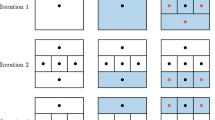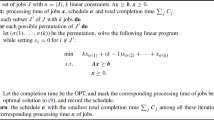Abstract
The availability of an LP routine where we can add constraints and reoptimize, makes it possible to adopt an integer programming approach to the travelling-salesman problem.
Starting with some of the constraints that define the problem we use either a branching process or a cutting planes routine to eliminate fractional solutions. We then test the resulting integer solution against feasibility and if necessary we generate the violated constraints and reoptimize until a “genuine” feasible solution is achieved.
Usually only a small number of the omitted constraints is generated.
The generality of the method and the modest solution times achieved leads us to believe that such an LP approach to other combinatorial problems deserves further consideration.
Similar content being viewed by others
References
M. Bellmore and J.C. Malone, “Pathology of travelling salesman subtour elimination algorithms”,Operations Research 19 (1971) 278–307.
M. Bellmore and G.L. Nemhauser, “The travelling salesman problem: a survey”,Operations Research 16 (1968) 538–558.
G.B. Dantzig, D.R. Fulkerson and S.M. Johnson, “Solution of a large scale travelling salesman problem”,Operations Research 2 (1954) 393–410.
G.B. Dantzig, D.R. Fulkerson and S.M. Johnson, “On a linear programming, combinatorial approach to the travelling salesman problem”,Operations Research 7 (1959) 58–66.
W.L. Eastman, “Linear programming with pattern constraints”, Ph.D. Dissertation, Harvard University, Cambridge, Mass., (1958).
J. Edmonds, “Maximum matching and a polyhedron with 0, 1-vertices”,Journal of Research of the National Bureau of Standards 69B (1965) 125–130.
A.M. Geoffrion and R.E. Marsten, “Integer programming algorithms: A framework and state-of-the-art survey”,Management Science 18 (1972) 465–491.
K. Helbig Hansen and J. Krarup, “Improvements of the Held—Karp algorithm for the symmetric travelling-salesman problem”,Mathematical Programming 7 (1974) 87–96.
M. Held and R.M. Karp, “A dynamic programming approach to sequencing problems”,Journal of the Society for Industrial and Applied Mathematics 10 (1962) 196–210.
M. Held and R.M. Karp, “The travelling salesman problem and minimum spanning trees, Part II”,Mathematical Programming 1 (1971) 6–25.
L.L. Karg and G.L. Thompson, “A heuristic approach to solving travelling salesman problems”,Management Science 10 (1964) 225–248.
A. Land and S. Powell,Fortran codes for mathematical programming (Wiley, New York, 1973).
J.D. Little, K.G. Murty, D.W. Sweeney and C. Karel, “An algorithm for the travelling salesman problem”,Operations Research 11 (1963) 972–989.
G.T. Martin, “Solving the travelling salesman problem by integer linear programming”,CEIR, New York (1966).
C.E. Miller, A.W. Tucker and R.A. Zemlin, “Integer programming formulations and travelling salesman problems”,Journal of the Association for Computing Machinery 7 (1960) 326–329.
J.D. Murchland, “A fixed matrix method for all shortest distances in a directed graph and for the inverse problem”, Ph.D. Dissertation, Karlsruhe (1970).
D. Shapiro, “Algorithms for the solution of optimal cost travelling salesman problem”, Sc.D. Thesis, Washington University, St. Louis, Mo. (1966).
“Computers in Central Government: Ten Years Ahead”, Civil Service Department,Management Studies 2, HMSO London (1971) (no authors reported).
Author information
Authors and Affiliations
Rights and permissions
About this article
Cite this article
Miliotis, P. Integer programming approaches to the travelling salesman problem. Mathematical Programming 10, 367–378 (1976). https://doi.org/10.1007/BF01580682
Received:
Revised:
Published:
Issue Date:
DOI: https://doi.org/10.1007/BF01580682




